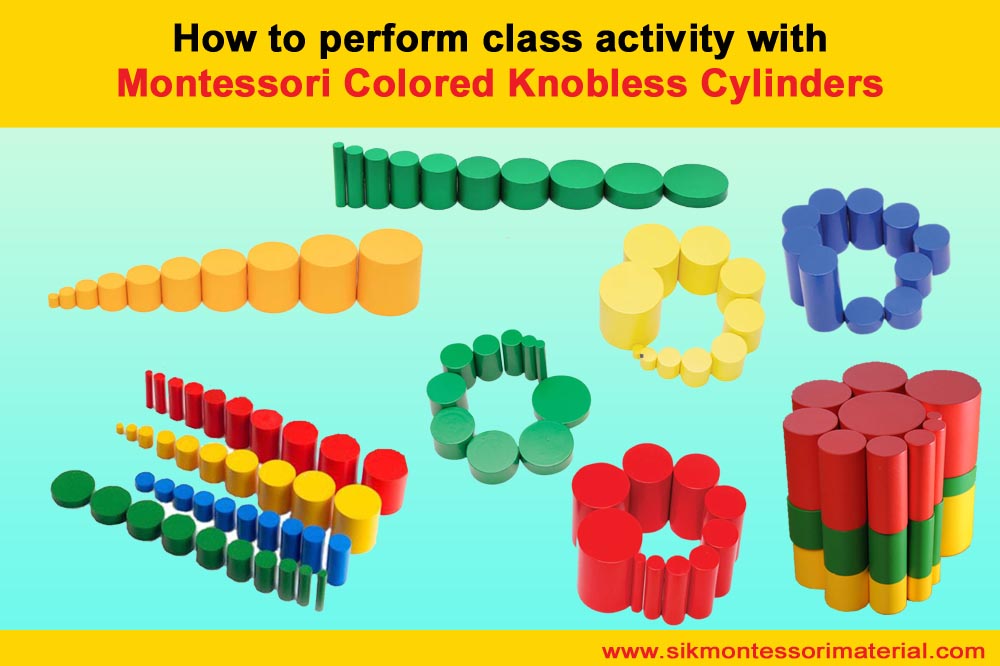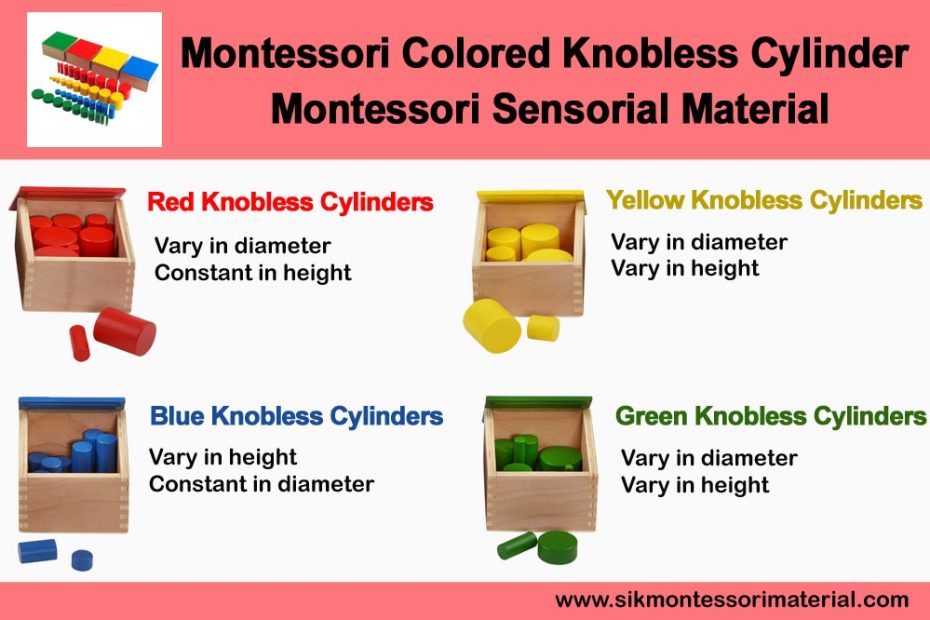If you’re familiar with the Montessori education approach, you’ll know that it emphasizes hands-on learning and sensory exploration. Montessori material is the best option for children to learn by performing creative activities. Montessori sensorial activities are some of the most engaging activities that can improve the cognitive skills of a child. Montessori sensorial material include different set of items to perform different activities. One of the key materials in Montessori’s sensorial curriculum is the Knobless Cylinder Sets. These sets offer a unique way for children to refine their senses and develop various skills. In this article, we’ll delve into the world of Colored Knobless Cylinders, exploring their components, benefits, and usage within the Montessori classroom.
What are the Four Knobless Cylinder Sets?
Knobless Cylinder Sets are an integral part of Montessori’s sensorial materials. These sets consist of several cylinders varying in height and diameter, but without knobs. The goal of this material is for children to differentiate and match cylinders by size. The colored Knobless cylinders are 4 sets (each set in a box) of 10 wooden cylinders differentiated by color, size, and shape. Each box has a lid that matches the color of the cylinders contained inside. The knobless cylinders are parts of the sensorial Montessori kit and they refine visual distinction between the heights and diameters of three-dimensional forms for new learners.
The colored knobless cylinders mirror the knobbed cylinder sets in every aspect, excluding the knobs and coloration. They are also compatible with the four-cylinder blocks. These colored knobless cylinders hold the position of the 5th material in the sequence, succeeding the Knobbed Cylinders, Pink Tower, Broad Stair, and Red Rods. Each box of cylinders is systematically distinct from other cylinder box in either one or two dimensions, which could be height and/or diameter.
The four Knobless Cylinder Sets are:
1.
Red Knobless Cylinders

Red Knobless Cylinders
In the Red Knobless Cylinder Set, height remains constant and the focus shifts to diameter. Children learn to discriminate between cylinders based on width, honing their visual and tactile senses.
2.
Blue Knobless Cylinders

Blue Knobless Cylinders
The Blue Knobless Cylinder Set introduces children to the concept of differentiating by height. The diameter of the cylinders remains constant but height among the cylinders vary that provides an initial grasp of relative dimensions.
3.
Yellow Knobless Cylinders

Yellow Knobless Cylinders
In Yellow Knobless Cylinder Set, both height and diameter vary from thick to thin and tall to short. This set offers a more complex challenge, as children must consider multiple dimensions when matching the cylinders.
4.
Green Knobless Cylinders

Green Knobless Cylinders
The Green Knobless Cylinder Set takes the challenge further by introducing variations in both height and diameter simultaneously. This set encourages refined discrimination and careful observation. All the 10 green cylinders vary in both height and width, with the shortest being the thickest and the tallest being the thinnest.
What Age Can You Introduce the Montessori Knobless Cylinders?
The Knobless Cylinder Sets are typically introduced to children around the age of 3 to 4. This is a stage where their sensory exploration and fine motor skills are developing rapidly. The material caters to their innate curiosity and encourages hands-on learning.
This Montessori material is usually introduced to children during their first year in the primary program, usually around the middle of the year. This happens after the child has spent time with the Knobbed Cylinders, which share a somewhat similar idea but have stricter error control. You can introduce this material as soon as possible. Yet, if the child isn’t interested, avoid pushing them. Wait until they’re eager to use it. This Montessori sensory material can also be used with older children, but be cautious that the cylinders’ height or width doesn’t pose a choking risk. Always supervise older children when they’re playing with these materials.
Ensuring Safe Usage of Montessori Cylinder Blocks with Children
When using Montessori Cylinder Blocks with children, it’s essential to prioritize safety. To prevent choking hazards, supervise children closely during play, especially those prone to putting objects in their mouth. Only introduce the blocks to children past the age of mouthing behaviors. Regularly inspect the blocks for any loose parts, and educate children about the dangers of putting small objects in their mouth. By following these steps, you can create a secure learning environment for children to explore the Cylinder Blocks.
How to perform class activity with Montessori colored Knobless Cylinders:
There are many ways to present the Montessori Knobless Cylinders to your children. Here are some ideas on how to make it more interesting for them. Each set has a different presentation.

- The red set is presented first. Ask any one of the learners to carry the box of red Knobless Cylinders to the table or mat where you are intended to perform an activity.
- Remove the lid and place it to the right of the box. Remove cylinders from the box and place randomly on the mat with the largest near the smallest for contrast. Place a thickest one and ask the students to lines other cylinders thickest to thinnest in a horizontal line. During the presentation, as well as after, comparative and superlative language is reviewed (i.e. “Can you show me a thicker cylinder?” or “Which cylinder is thinnest?” After grading the cylinders, the student stands up and looks down at the cylinders.
- The next task is to build a tower by placing the thickest cylinder at the base and building up to the thinnest. After building the tower, the child stands above it and looks down.
- Ask the learners to practice this activity at their own time. During the course of activity, encourage them to learn vocabulary and try to engage all learners so that they perform with their own hands.
- After the child has mastered the red set, subsequent blocks are presented: blue, yellow, and then green. All towers should be built with the thickest piece at the base, except blue. Because the cylinders in blue set has same diameter but varies in height. So, building a tower from blue cylinders, ask the students to place tallest cylinder at the base and shortest at the top.
- A verity of activities can be performed by combination of four set together. Set out all four boxes of Knobless Cylinders and encourage your kid to stack cylinders with the same diameter. This will help your kid in developing their visual discrimination skills. Comparing the red and green pieces side to side and then green on top of the red. Next is red and yellow, then green and yellow, and then red and blue, after that three boxes at a time, and finally all four.
- Another activity that can be performed by knobless cylinders is using all the four boxes of Montessori Knobless Cylinders, have your children make shapes such as diamonds or squares. Their aim is to fill up the space on the table with cylinders of a particular shape. This will help them to develop their hand-eye coordination and control over error.
- The last activity that you can do by your students is using the four boxes of Knobless Cylinders. You can ask your kids to count the number in each box. When they have finished counting, ask them if they can tell how many cylinders are in each box. This will help them develop their ability to count and see patterns in numbers.
- When it’s time to end the activity, ask your kid that the cylinder must be put back in the box, the largest cylinder first and small cylinder at the last.
Vocabulary associated with Knobless Cylinder activity:
Before delving deeper into the practical aspects, let’s familiarize ourselves with the vocabulary commonly associated with the Knobless Cylinder activity:
Cylinders: Three-dimensional objects with circular cross-sections that vary in height and diameter. Through work with the Knobless Cylinders, children are also introduced to the different grading vocabulary.
Discrimination: The ability to recognize differences between objects based on specific attributes.
- short, shorter, shortest
- tall, taller, tallest
- thin, thinner, thinnest
- thick, thick, thickest
Sensorial: Pertaining to the senses and sensory experiences. Student can learn the name of colors:
- Red
- Blue
- Yellow
- Green
Purpose of Introducing Knobless Cylinders
The Knobless Cylinder Sets serve several essential purposes within the Montessori curriculum:
Sensory Development: Children refine their tactile and visual senses by feeling and comparing the cylinders’ dimensions.
Fine Motor Skills: Grasping and manipulating the cylinders enhance hand-eye coordination and dexterity.
Discrimination: The activity hones the child’s ability to notice subtle differences between diameter and height of the objects, a skill applicable across subjects.
Grasping Concept of Size and Order: Learners stack and arrange cylinders in different order that build capability of recognizing size and order of the objects. It helps the child prepare for more complex topics in mathematics such as comparison, grading, and seriation with varying combinations different colored knobless cylinders.
Focus and Concentration: Engaging with the material requires sustained attention, fostering concentration.
Learning Vocabulary: The children learn different terms that determine size and diameter. These terms include: tall, short, thin, thick, taller, thinner, shorter, thicker, tallest, thinnest, shortest, and thickest.
Control of Error
Montessori materials often have a built-in “control of error.” In the case of Knobless Cylinders, the child’s control of error is visual and tactile. If the cylinders do not fit precisely, the child can perceive the mismatch without external feedback.
Points of Interest
The absence of knobs encourages the child to focus on the sensory attributes of the cylinders. The attractive colors of the cylinders make children busy in activities and they love to play with it. The difference in size of each cylinder create a uniqueness and children can perform verity of activities. The gradual progression from simple to complex sets ensures a gradual challenge.
Final Thoughts
The Montessori Knobless Cylinder Sets exemplify Maria Montessori’s educational philosophy by engaging children’s senses and facilitating independent exploration. These materials promote cognitive development, critical thinking, and a lifelong love for learning.
Frequently Asked Questions
Can children work with Knobless Cylinder Sets individually?
Yes, the design of the material encourages independent exploration and self-correction.
Are Knobless Cylinder Sets only used for sensorial development?
While primarily used for sensorial development, these sets indirectly enhance other skills such as vocabulary and concentration.
What is demonstrating order of Knobless Cylinders?
The Knobless Cylinders are introduced to children on bases of their task difficulty. Red cylinder are considered easy and children can learn quickly and followed by yellow, then green, and finally blue because blue cylinders are bit tricky to use.
Why we call Knobless Cylinders?
The Montessori Sensorial Material contains two sets of cylinders. One set has knobs on the top of cylinder to hold it. Second set is identical to first set but it is without knobs. So that why we call it knobless cylinders.
What happens if a child struggles with a specific set?
It’s essential to observe the child’s progress and provide support if needed. Revisit simpler sets before moving on to more complex ones.
Can Knobless Cylinder Sets be used at home or only in a classroom setting?
These sets can certainly be incorporated into a home environment, providing valuable learning opportunities outside the classroom.
Are there extensions to the Knobless Cylinder activity?
Educators often develop extensions that combine this material with math or language concepts, expanding its educational scop
